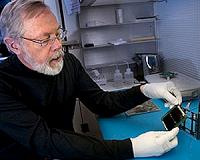 |
Boulder CO (SPX) Jan 29, 2010 A tiny communications satellite designed and built by University of Colorado at Boulder undergraduates has been selected as one of three university research satellites to be launched into orbit in November as part of a NASA space education initiative. The three satellites, dubbed "CubeSats" because of their shape, were built by CU-Boulder, Montana State University and Kentucky Space, which is a consortium of state universities. CubeSats are roughly four inches on a side, have a volume of about one quart and weigh about 2.2 pounds. The satellites are being flown as part of NASA's Educational Launch of Nanosatellite, or ELaNA, mission, said Chris Koehler, director of the Colorado Space Grant Consortium, or COSGC, which is headquartered at CU-Boulder. The CU-Boulder satellite, named Hermes, was designed, built and tested by roughly 100 COSGC students on the CU-Boulder campus - nearly all undergraduates - over a period of about two and one-half years, said Koehler. The goal of the mission is to improve communications systems in tiny satellites through on-orbit testing of a high data-rate communication system that will allow scientists and engineers to downlink large quantities of information. "This is great news for the students and for the Colorado Space Grant Consortium," said Koehler. "This is a homegrown CU-Boulder satellite and these students have pushed the capabilities of communication systems by integrating them into a very tiny satellite." Based in the CU-Boulder College of Engineering and Applied Science, COSGC is funded by NASA and is a statewide organization involving 16 colleges, universities and institutions around Colorado. Koehler said it is challenging to find launch opportunities for student satellites like Hermes. The three student satellites will be attached to a Taurus XL launch vehicle that also will launch NASA's Glory mission to study solar radiation. CU-Boulder's Laboratory for Atmospheric and Space Physics designed and built a multimillion dollar solar payload for the Glory mission known as the Total Irradiance Monitor that will measure the total light coming from the sun at all wavelengths to help determine the energy balance of the planet. CU-Boulder senior Nicole Doyle, project manager for Hermes and an aerospace engineering sciences department major, said the satellite has two communications systems. "One will allow us to 'talk' to the satellite and the other one will be used to test the high-speed communications system. If we are successful, the hopes are it can be used on other satellites." The three CubeSat satellites will be attached to the Taurus XL rocket in a mechanical system known as a PPOD developed by the California Polytechnic State University in partnership with Stanford University. Once the rocket reaches about 385 miles high, the satellites will be ejected from the PPOD and will spring off into separate orbits, said Doyle. The CU-Boulder satellite will be in contact with a COSGC ground station atop the Discovery Learning Center at the CU-Boulder engineering college. A second ground station is being built by the COSGC students in Longmont, about 15 miles northeast of Boulder, to monitor the high-speed communications data system, said Doyle. "We are all really excited for launch," said Doyle. "We are now in our final push to test the communication sequence system and to finish our environmental testing, which includes vibration and vacuum chamber tests to verify that the satellite can survive in orbit." Doyle said that when she got to CU-Boulder she was surprised to discover undergraduates had regular opportunities to design, build, test and fly spacecraft. "A number of students in my classes were talking about building satellites, so I decided to see what it was all about. That's when I came into the Colorado Space Grant Consortium," she said. "This has been an incredible experience for me," said Doyle. "We learn from other CU students who are working on other space projects and who have experience in the kinds of research we are doing with Hermes. This is a great opportunity for students like me who want to work in the aerospace industry after college." COSGC provides Colorado higher education students access to space through innovative courses, real-world, hands-on space hardware and satellite programs. The students interact with engineers and scientists from NASA and aerospace companies to develop, test and fly new space technologies on high-altitude balloons, sounding rockets and orbiting satellites. Of the 52 space grant consortiums in the United States, Colorado's has been active in designing, building and flying 10 sounding rocket payloads, three space shuttle payloads, a satellite and hundreds of balloon experiments in the past 20 years, Koehler said.
Share This Article With Planet Earth
Related Links COSGC Space Technology News - Applications and Research
 MSU Satellite To Accompany NASA Mission Into Space
MSU Satellite To Accompany NASA Mission Into SpaceBozeman MT (SPX) Jan 29, 2010 It's official. A small research satellite that Montana State University students built to commemorate the 50th anniversary of the first successful U.S. satellite will ride into space this fall on a NASA launch. Calling it "a historically huge moment," David Klumpar, director of MSU's Space Science and Engineering Laboratory, said this will be the first time that an MSU satellite will be la ... read more |
|
| The content herein, unless otherwise known to be public domain, are Copyright 1995-2009 - SpaceDaily. AFP and UPI Wire Stories are copyright Agence France-Presse and United Press International. ESA Portal Reports are copyright European Space Agency. All NASA sourced material is public domain. Additional copyrights may apply in whole or part to other bona fide parties. Advertising does not imply endorsement,agreement or approval of any opinions, statements or information provided by SpaceDaily on any Web page published or hosted by SpaceDaily. Privacy Statement |